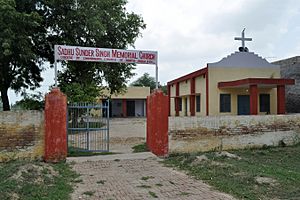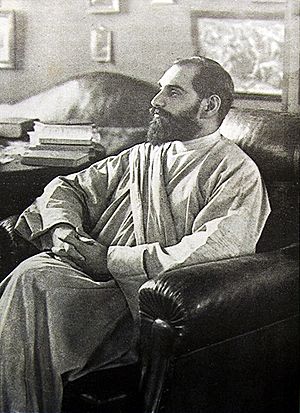Sadhu Sundar Singh facts for kids
Quick facts for kids Sadhu Sundar Singh |
|
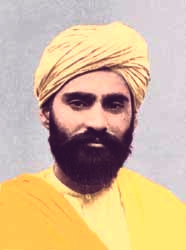 |
|
| Born | 3 September 1889 in Ludhiana, Punjab, British India (present-day Punjab, India) |
|---|---|
| Died | c. 1929 (aged around 39-40) in Himalayas |
| Education | Anglican College, Lahore Ewing Christian School, Ludhiana |
| Congregations served | Reformers |
| Title | Sadhu |
| St. Sundar Singh of India The Apostle of the Bleeding Feet |
|
|---|---|
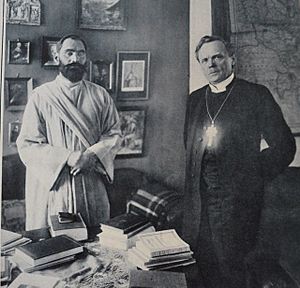
Sadhu Sundar Singh with Archbishop Nathan Söderblom, during his stay in Sweden
|
|
| Sadhu (holy man), Evangelist, Teacher of the Faith | |
| Venerated in | Anglican Communion |
| Feast | 19 June (Anglican Communion) |
Sadhu Sundar Singh (born September 3, 1889 — disappeared around 1929) was an Indian Christian missionary. He was a special kind of holy man, known as a Sadhu, who shared the Christian message. He is believed to have disappeared in the Himalayas mountains in 1929.
Contents
Biography
Early Life and Spiritual Search
Sundar Singh was born in 1889 in a Sikh family in Rampur, a village in northern India. His mother taught him about faith and took him to meet a Hindu sadhu, a holy man who lived in the jungle. She also sent him to an English school.
When Sundar was 14, his mother passed away. He was very angry and even burned pages from a Christian Bible. He also studied the Bhagavad Gita, a Hindu holy book, at home.
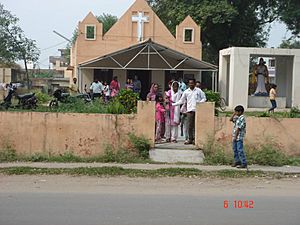
Finding His Path
Sundar felt that his religious studies and talks with priests did not give him the answers he was looking for. One day, he had a vision of Jesus. After this, Sundar told his father, Sher Singh, that he wanted to follow Jesus and become a missionary.
His father did not agree and rejected him. His brother even tried to poison him several times. People in his area also tried to harm him, but a British Christian helped him.
On his 16th birthday, he was publicly baptized as a Christian. This happened in a church in Shimla, a town in the Himalayan foothills. Before this, he had been helping people with leprosy at a Christian mission nearby.
Life as a Christian Sadhu
In October 1906, Sundar Singh began his journey as a Christian. He wore a saffron turban and a saffron robe, like a traditional Indian sadhu. He chose to be a Christian sadhu because he believed Indians would understand Christianity better if it was presented in an Indian way.
He said he wanted to live simply, without a home or many things, just like Jesus. He wanted to travel, share in people's suffering, and tell everyone about God's love.
After visiting his home village, where he received a warm welcome, Sundar Singh traveled widely. He went through Punjab, into Kashmir, and even into Afghanistan and other challenging areas.
In 1908, he crossed into Tibet, where he saw very difficult living conditions. He also tried to visit Palestine but could not get permission.
He felt that Western culture, with its focus on money and power, was very different from the original Christian values. He wanted Indian Christians to keep their Indian identity instead of adopting British customs.
Training and Independence
In December 1909, Singh started training at an Anglican college in Lahore. He didn't connect much with other students and felt different.
He was not used to the rules and traditions of the Anglican church. He felt that much of the college's lessons were not helpful for sharing the gospel in India. After eight months, he left the college in July 1910.
It is said that a bishop told him he needed to stop wearing his sadhu robe and wear European clothes. He was also told to follow formal church services and not preach outside his area without permission. Sundar Singh believed that spreading Jesus's message was most important, and he did not want to mix it with British culture. So, he chose to continue his work as an independent sadhu.
Amazing Stories and Journeys
Stories from these years are quite amazing. Some people thought they were miracles. For example, in 1912, he said he found a 300-year-old hermit (a person living alone for religious reasons) in a mountain cave in Kailas. He spent weeks with this holy man.
He also claimed that in a town called Rasar, he was thrown into a dry well filled with bones and left to die. But he said he was rescued three days later.
There were also stories about a secret group of missionaries in India, said to have 24,000 members. Sundar Singh said he had visions about this group, and his spiritual life was often guided by visions.
It's not known how many people became his followers during his difficult trips to Tibet. He didn't keep written records, and he traveled alone, so there were no witnesses to his amazing stories.
Traveling the World
As Sundar Singh grew older, his work became known worldwide. People said he was humble and kind, with a good sense of humor and a love for nature. His talks were powerful because he used simple examples from everyday life. Many people said he not only looked like Jesus but also spoke like him. He meditated every morning, especially on the gospels, which helped his speeches.
In 1918, he toured South India and Ceylon (now Sri Lanka). The next year, he was invited to Burma, Malaya, China, and Japan.
Some stories from these trips were as strange as his adventures in Tibet. He claimed to have power over wild animals and even over sickness, though he never wanted his healing gifts to be widely known.
Sundar Singh had always wanted to visit Britain. His father, who had also become a Christian, gave him money for the trip. He visited Western countries twice: Britain, the United States, and Australia in 1920, and Europe again in 1922. Christians from many different churches welcomed him.
He was surprised by what he saw in the West. He felt there was too much focus on money and not enough on spiritual life, which he compared to Asia's awareness of God. After returning to India, he continued his work, even though he was becoming physically weaker.
Final Journey
In 1923, Singh made his last regular summer trip to Tibet and came back very tired. It seemed his days of preaching were over. For the next few years, he stayed at home or with friends in the Simla hills, spending his time meditating and writing about his beliefs.
In 1929, even though his friends advised him not to, Singh wanted to make one last journey to Tibet. He was last seen on April 18, 1929, starting this journey. In April, he reached Kalka, a small town below Simla. He looked older than his years, dressed in his yellow robe, among other pilgrims. What happened to him after that is a mystery. No one knows if he died from exhaustion or reached the mountains.
In the early 1940s, another missionary, Bishop Augustine Peters, found Sundar Singh's brother, Rajender. He helped Rajender become a Christian and baptized him. Rajender Singh spoke about many miracles that Sundar Singh was said to have performed and how many people became Christians because of him.
Many people see Sundar Singh as a very important figure in the history of the Christian church in India.
Remembered by Christians
Sundar Singh is respected in the Malankara Syrian Orthodox Church and the Coptic Church. The Church of England remembers him with a special day of honor on June 19.
In 2022, Sundar Singh's story was made into a two-part radio show by Pacific Garden Mission's Unshackled! ministry.
Timeline
- 1889 – Born at Rampur Kataania, Ludhiana, Punjab
- 1903 – Becomes a Christian
- 1904 – Leaves home
- 1905 – Baptized in Simla; starts life as a sadhu
- 1907 – Works in a leprosy hospital
- 1908 – First visit to Tibet
- 1909 – Starts training at Divinity College, Lahore
- 1911 – Decides to preach independently as a sadhu
- 1912 – Travels through north India and the Himalayas
- 1918 to 1922 – Travels worldwide
- 1923 – Tries to go to Tibet but returns due to health
- 1925 to 1927 – Spends time writing
- 1927 – Tries to go to Tibet again but returns due to illness
- 1929 – Last attempt to reach Tibet
- 1972 – Sadhu Sundar Singh Evangelical Association is formed
Works by Sundar Singh
Sundar Singh wrote eight books between 1922 and 1929. He wrote them in Urdu, and they were later translated into English and other languages.
- At the Master's Feet (1922). Electronic versions: Google Books and CCEL.
- With and Without Christ (1929). Archive.org
- The Real Life (published after his disappearance; 1965).
- The Real Pearl (published after his disappearance; 1966).
- Reality and Religion: Meditations on God, Man and Nature (1924). Google Books
- The Search after Reality: Thoughts on Hinduism, Buddhism, Muhammadanism and Christianity (1925). Google Books
- Meditations on Various Aspects of the Spiritual Life (1926). Archive.org
- Visions of the Spiritual World (1926). Archive.org
Other people also collected and edited his works:
- The Cross Is Heaven: The Life and Writings of Sadhu Sundar Singh, edited by A. J. Appasamy (1956). – A collection of short articles by Sundar Singh.
- Life in Abundance, edited by A. F. Thyagaraju (1980). – This book contains his sermons preached in Switzerland in 1922.
- The Christian Witness of Sadhu Sundar Singh: A Collection of His Writings, edited by T. Dayanandan Francis (1989).
See also
 In Spanish: Sandhu Sundar Singh para niños
In Spanish: Sandhu Sundar Singh para niños


